|
|
|
Sort Order |
|
|
|
Items / Page
|
|
|
|
|
|
|
| Srl | Item |
| 1 |
ID:
130702
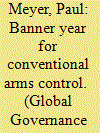

|
|
|
|
|
| Publication |
2014.
|
| Summary/Abstract |
THE CONTROL OF CONVENTIONAL ARMS HAS OFTEN SEEMED THE POOR COUSIN of the global efforts to control weapons of mass destruction (WMD). Since the advent of the atomic era, the focus of arms control and disarmament activity has been overwhelmingly on nuclear weapons and their lesser, if still ugly, stepsisters of biological and chemical weapons. The initial multilateral arms control agreements concerned themselves with limits on the testing of nuclear weapons and, shortly thereafter, with their nonproliferation (e.g., the Nuclear Nonproliferation Treaty of 1968). Bilateral US-Soviet/Russian arms control arrangements also predominantly dealt with the reduction of strategic nuclear forces and restraints on deployments of defenses against (nuclear tipped) ballistic missiles. Efforts to reduce major conventional weapon systems were also taken up in the 1980s in the context of negotiations
between the opposing alliances of NATO and the Warsaw Pact, eventually culminating in the Treaty on Conventional Forces in Europe (CFE Treaty) of 1989. This treaty provided for a massive reduction in the conventional forces that had confronted each other for years in Central Europe and established a new, far more stable security order on the continent. Even the CFE Treaty, however, tended to be overshadowed by other major disarmament agreements concluded in those heady post-Cold War days: the Intermediate Nuclear Forces Treaty (1987), Chemical Weapons Convention (1993), Comprehensive (Nuclear) Test Ban Treaty (1996), and various US-Russian bilateral strategic nuclear arms accords of the 1990s and early 2000s (e.g., the Strategic Arms Reduction Treaty and the Strategic Offensive Reductions Treaty).
|
|
|
|
|
|
|
|
|
|
|
|
|
|
|
|
| 2 |
ID:
131417
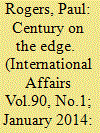

|
|
|
|
|
| Publication |
2014.
|
| Summary/Abstract |
The article argues that the century from 1945 is likely to prove seminal in terms of human progress. It marks the period when the human community has to come to terms with its capacity for self-destruction through the invention of weapons of mass destruction and its ability to exceed the homeostatic capabilities of the global ecosystem in an era of deep socio-economic divisions. Two-thirds of the way through this century the progress has been mixed. Nuclear war has been avoided more by luck than by wisdom, there remain risks of nuclear proliferation and it is not evident that humankind has acquired the ability to deal with the destructive potential of bio-, nano- and other emerging technologies. Recognition of the extent of anthropogenic impacts on ecosystem stability is evident, but not at the level necessary for the radical responses required. Even so, there are signs of progress and potential for change, suggesting that the final one-third of the century will be singularly important in ensuring long-term emancipation and environmental sustainability.
|
|
|
|
|
|
|
|
|
|
|
|
|
|
|
|
| 3 |
ID:
133050
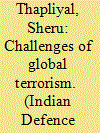

|
|
|
|
|
| Publication |
2014.
|
| Summary/Abstract |
There should be no distinction between a good and a bad terrorist which is what some countries are trying to do. The scourge will consume all unless it is ruthlessly eliminated. Countries sponsoring terrorism might realise that it is like riding a tiger that, one day, they might tall prey to. The biggest worry at these countries which have sulterecl at the hands at terrorists is that Weapons of Mass Destruction may fall into the hands at the terrorists and that catastrophic consequences would tollowi A worldwide integrated approach to tackling terrorism is, therefore, a must.
|
|
|
|
|
|
|
|
|
|
|
|
|
|
|
|
| 4 |
ID:
130342


|
|
|
|
|
| Publication |
2014.
|
| Summary/Abstract |
As the U.S. government winds up an interagency review of rules governing the export of large drones, the conflicting goals of nonproliferation and commerce are creating a new test of the 27-year-old Missile Technology Control Regime (MTCR). Observers do not expect big changes to the MTCR, which seeks to prevent the proliferation of unmanned systems capable of delivering weapons of mass destruction. The MTCR, a voluntary arrangement that now includes 34 countries, originally was intended to curb the spread of ballistic missiles and unmanned vehicles capable of carrying nuclear weapons. In 1993 it was amended to control systems carrying any weapons of mass destruction. It has become Washington's chief tool for controlling the spread of armed drones. "It's quite unlikely that we will see any radical change in the MTCR," Eric McClafferty, an attorney at Kelley Drye and Warren, a law firm in Washington that represents UAV manufacturers, said in a March 19 interview. "That said, there's a lot of pressure on the U.S. government to liberalize controls to make sure the U.S. doesn't get left behind in this market." The conflict has played out in a series of closed-door meetings over the last two months among the State, Defense, and Commerce departments as officials seek to update U.S. policy toward the burgeoning UAV market. Industry representatives have made their views known via technical committees that advise policymakers in these departments. "It's a pretty contentious fight" between the State Department's Bureau of International Security and Nonproliferation and the Pentagon's Defense Technology Security Administration, said Micah Zenko, a fellow at the Council on Foreign Relations, in a March 17 interview. The State Department says that "if you pull at the thread of MTCR, you will weaken the nonproliferation regime as a whole. The other side says the international market is going to supply these UAVs anyway," Zenko said. The heart of the issue is what kind of UAVs U.S. manufacturers can sell overseas. The MTCR imposes a "presumption of denial" for the export of so-called Category 1 UAV's, which are drones that can travel more than 300 kilometers with a payload of more than 500 kilograms. Drones that do not have those capabilities are classified as Category 2 UAVs and are not subject to such restrictive criteria. Two drones currently classified as Category 1-the Reaper, formerly known as the Predator, and the Global Hawk-have played a central role in U.S. aerial attacks on suspected Islamic militants in Pakistan, Somalia, and Yemen. Washington has approved the sale of an armed drone to only one country, the United Kingdom, although unarmed versions of these drones have been sold to Italy and South Korea.
The stakes of the MTCR review process are large politically and economically, observers say.
|
|
|
|
|
|
|
|
|
|
|
|
|
|
|
|
| 5 |
ID:
130360
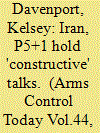

|
|
|
|
|
| Publication |
2014.
|
| Summary/Abstract |
Iran and six world powers held "constructive and useful" talks on a comprehensive deal on Iran's nuclear program, according to a March 19 joint statement released by the parties. A main topic of the talks between Iran and the six-country group, known as the P5+1 (China, France, Germany, Russia, the United Kingdom, and the United States), was Iran's uranium-enrichment program. The March 17-19 talks in Vienna were the second set of meetings between Iran and the P5+1 on a comprehensive deal on Iran's nuclear program after the parties reached an interim agreement in November. Implementation of the initial actions began Jan. 20 and is to last six months. If an agreement is not reached, the interim deal can be extended by mutual consent of the two sides. U.S. officials have said they hope to reach a final deal within the first six months. Iran maintains that its nuclear program is for peaceful purposes, but some countries are concerned that Iran could use its nuclear capabilities to develop nuclear weapons.
|
|
|
|
|
|
|
|
|
|
|
|
|
|
|
|
| 6 |
ID:
132300
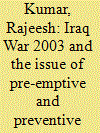

|
|
|
|
|
| Publication |
2014.
|
| Summary/Abstract |
The adoption of pre-emptive self-defence as a policy by the United States of America in its war against terrorism has revived the controversy over the concept of pre-emptive use of force in international politics. Some scholars argue that states are stretching the right of self-defence as pre-emptive, preventive and anticipatory in accordance with their needs and interests and to justify their actions. For others, in the context of changing security threats such as terrorism and Weapons of Mass Destruction pre-emptive strikes are permissible. These efforts to redefine and re-interpret the right of self-defence and use of force for justifying state's actions have challenged the role of international organisations that were principally designed to regulate the unilateral use of force, and to maintain international peace and security. Against this backdrop, this article will examine how the pre-emptive and preventive use of force undermines the role of the United Nations in international politics through probing the case of Iraq War 2003. This would be a much needed reflection on the implications of Iraq War on multilateralism in the context of 10 years after the war.
|
|
|
|
|
|
|
|
|
|
|
|
|
|
|
|
| 7 |
ID:
130017
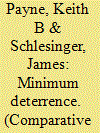

|
|
|
|
|
| Publication |
2014.
|
| Summary/Abstract |
Minimum Deterrence proposals claim that a relatively small number of nuclear weapons, measured in single digits to hundreds, is an adequate nuclear force for all pertinent U.S. deterrence missions, including extending U.S. nuclear deterrence coverage to U.S. allies. The vulnerability of an adversary's population and economy to nuclear weapons and the assumed high value of these targets to opposing leaders is the basis for the confident claims of Minimum Deterrence proponents that U.S. deterrence requirements can be met with a small number of nuclear weapons.
Contemporary proponents of Minimum Deterrence often argue that reducing to low nuclear force levels would:
1. provide deterrence that is more "stable" and greater safety than otherwise would be the case;
2. facilitate nuclear arms control agreements and successful non-proliferation policies;
3. provide substantial savings in the defense budget; and,
4. help create the conditions necessary for a more peaceful world order and help realize the goal of eliminating nuclear weapons entirely, i.e., "nuclear zero."
Recently, some U.S. officials and serving military officers have openly expressed support for the basic points and recommendations of Minimum Deterrence. Given the increased visibility of Minimum Deterrence and its potential to shape forthcoming U.S. policy decisions, it is important to identify the fundamental assumptions, logic and related conclusions of Minimum Deterrence proposals, and determine whether they are sound and consistent with available empirical evidence.
Minimum Deterrence claims generally are predicated on the following series of eight interrelated propositions:
v Deterrence will function reliably and predictably at low U.S. nuclear force numbers, now and in the future. U.S. conventional forces can substitute in many cases for nuclear forces to meet U.S. deterrence goals.
v Nuclear deterrence considerations no longer are pertinent to U.S. relations with Russia and China.
v Nuclear weapons are irrelevant to today's most pressing security threat-weapons of mass destruction (WMD) terrorism.
v Deterrence considerations alone determine the size and composition of the nuclear force requirements.
v Ballistic missile submarines (SSBNs) will remain invulnerable for 30 to 50 years. So, a small SSBN fleet can provide most or all of the nuclear capability needed for U.S. deterrence needs, now and in the future.
v The number of nuclear weapons and the risk of accidents and crises are directly correlated (more nuclear weapons means increased risk, while a decrease in their number reduces the risk).
v U.S. nuclear force reductions are essential to, and will strengthen, nonproliferation efforts; reductions also will facilitate further arms control progress. The Nuclear Non-Proliferation Treaty (NPT) requires U.S. movement toward nuclear disarmament.
v A small number of nuclear weapons is adequate for deterrence; thus U.S. defense spending can be reduced considerably by reducing nuclear forces.
Not all proposals for Minimum Deterrence include each of the eight elements. Several are of more recent vintage. But, a systematic examination reveals that these elements, implicitly or explicitly, are part of the contemporary Minimum Deterrence narrative.
The Obama administration's expressed policy positions undergirding its initiatives for nuclear reductions implicitly or explicitly reflect some, but not allof these eight Minimum Deterrence points. Particularly apparent in this regard is the presumed ability to predict with confidence and precision how deterrence and extended deterrence will work at much lower U.S. nuclear force levels.
Each of these eight points is described and critically examined here.
|
|
|
|
|
|
|
|
|
|
|
|
|
|
|
|
| 8 |
ID:
128065
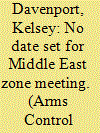

|
|
|
|
|
| Publication |
2013.
|
| Summary/Abstract |
Middle Eastern countries gathered last month to discuss the agenda for a conference on creating a zone free of weapons of mass destruction (WMD) in the Middle East, but made no announcement that they had made progress toward setting a date to convene the conference. The countries continue to disagree over the agenda, an official familiar with the process told Arms Control Today in an Oct. 29 e-mail. Iran, Israel, and all the Arab League countries attended the meeting, which was held Oct. 21-22 in Glion, Switzerland. Progress on the agenda has been held up over disagreements as to what weapons the zone's ban should cover because some countries favor expanding the ban to include limits on certain types of conventional weapons, the official said. The countries might meet again this month, the official added, but it is unclear if all will attend given the "frustration" over the lack of progress.
|
|
|
|
|
|
|
|
|
|
|
|
|
|
|
|
| 9 |
ID:
130041
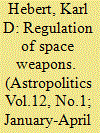

|
|
|
|
|
| Publication |
2014.
|
| Summary/Abstract |
The use of outer space continues to grow and is becoming more congested, competitive, and contested. This results in an increased need to ensure its protection. Existing international laws do not adequately regulate debris-causing space weapons and only provide restrictions for weapons of mass destruction. This article argues that there is a valid need to regulate space weapons, given the destabilizing effects of space weapons and the overall threat to the space environment. The article culminates with recommended courses of action for how to regulate space weapons.
|
|
|
|
|
|
|
|
|
|
|
|
|
|
|
|
| 10 |
ID:
130225
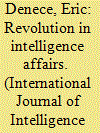

|
|
|
|
|
| Publication |
2014.
|
| Summary/Abstract |
That a "Revolution in Military Affairs" (RMA) took place in the early 1990s is widely known. The concept was born of technological, political, social, and economic changes that were to fundamentally alter the future of warfare, introducing a completely new type of military and organizational structure for the effective projection of force.
Though most experts accepted the reality of a fundamental transformation in the practice of warfare, few saw that a parallel revolution was occurring in the intelligence world, even though this specific field of national security was undergoing similar challenges and change.
That a "Revolution in Intelligence Affairs" in the 1990s and early 2000s actually occurred and its effects has become increasingly evident. This "intelligence revolution" resulted from a combination of changes in international politics, information technologies, and socio-political context.
|
|
|
|
|
|
|
|
|
|
|
|
|
|
|
|
| 11 |
ID:
131056
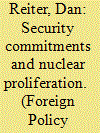

|
|
|
|
|
| Publication |
2014.
|
| Summary/Abstract |
This article develops a theory connecting security commitments and the decision to acquire nuclear weapons. In a threatening environment, third party security commitments can reduce a state's fear of abandonment in the event of war and its motive for acquiring nuclear weapons. However, a threatened state may reject at least some kinds of security commitments, such as foreign deployed nuclear weapons, if it fears that such commitments increase the risks of entrapment, the possibility that the threatened state will be dragged into a war it would like to avoid. The article looks at three kinds of security commitments, alliances, foreign deployed nuclear weapons, and foreign deployed troops. In quantitative tests, it finds strong evidence that foreign deployed nuclear weapons reduce proliferation motives, only very limited evidence that alliances reduce proliferation motives, and no evidence that foreign deployed troops reduce proliferation motives. It also presents several qualitative evidence, which supports the quantitative evidence, and in particular helps explain why alliance ties sometimes do not prevent proliferation.
|
|
|
|
|
|
|
|
|
|
|
|
|
|
|
|
| 12 |
ID:
133978


|
|
|
|
|
| Publication |
2014.
|
| Summary/Abstract |
In May 1982 the UK Royal Navy (RN) rushed the then brand new sea Shua anti ship missile into service in the South Atlantic. Equipping the similarly new Lynx HAS.2 small ships' helicopter, Sea Shua has been developed by British Aerospace Dynamics to give the Lynx a powerful punch against the missile-armed fast attack craft and corvettes, then proliferating in Soviet and Warsaw pact navies.
|
|
|
|
|
|
|
|
|
|
|
|
|
|
|
|
| 13 |
ID:
131618


|
|
|
|
|
| Publication |
2014.
|
| Summary/Abstract |
Meeting for the final time before their review conference next spring, parties to the nuclear Nonproliferation Treaty (NPT) gathered for two weeks at the United Nations, but were unable to adopt a common set of recommendations. This outcome could serve as a preview for the 2015 review conference, where disagreements are expected about the pace of nuclear disarmament efforts.
Enrique Román-Morey of Peru, who chaired the April 28-May 9 preparatory meeting, was unable to bridge differences and produce a consensus report on recommendations for the 2015 conference. At a May 9 press conference after the meeting ended, Román-Morey said agreement was not possible because there was not enough time to resolve key issues, such as the pace of disarmament by the nuclear-weapon states and the establishment of a Middle Eastern zone free of weapons of mass destruction.
|
|
|
|
|
|
|
|
|
|
|
|
|
|
|
|
|
|
|
|
|